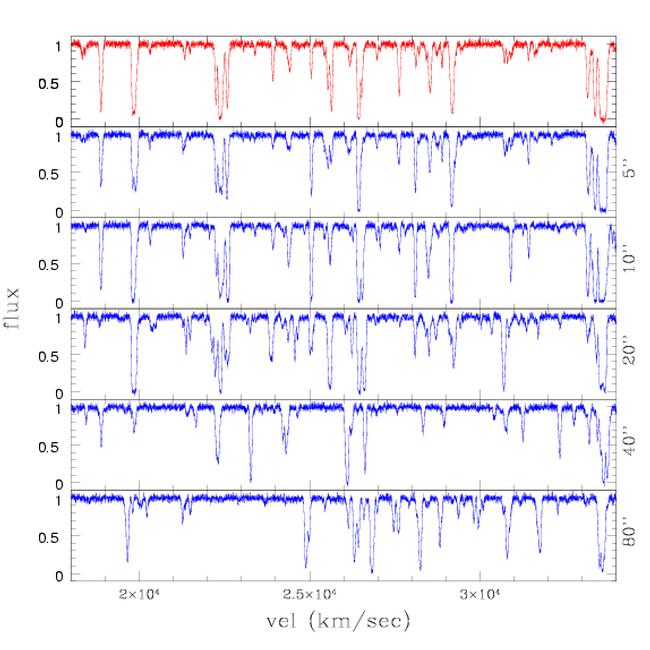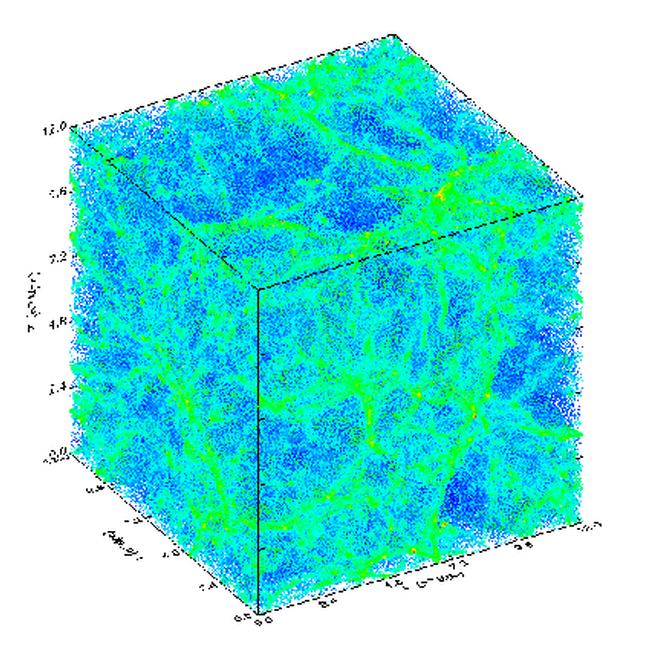Unveiling the Gas Distribution in the Early Universe |
A simple model has been developed at the Max-Planck-Institute for Astrophysics to study the distribution of the gas in the high redshift Universe.
According to current cosmological models the Universe is filled with gas and an unknown type of invisible, so called `dark', matter. Starting from a very homogeneous distribution, the gas, pulled by the gravitational attraction of perturbations in the dark-matter, evolves and gives rise to luminous objects, such as galaxies. In order to investigate the properties of the gas between the galaxies and to understand the fundamental process of galaxy formation, researchers study the light emitted by very distant quasars (QSOs), which are very luminous nascent galaxies at high redshift. Their light travels to us and is absorbed by the intervening inhomogeneous distribution of gas along the line of sight (LOS). By analysing the absorption features present in QSO spectra it is possible to infer the physical properties of the gas along the LOS, such as the temperature, velocity and chemical composition, and to unveil the spatial distribution of these absorbers.
The model, developed at the Max-Planck-Institut für Astrophysik (MPA) by H.J. Mo and visiting researchers from Padova (S. Matarrese, M. Viel), London (M. Haehnelt) and Cambridge (T. Theuns),is based on the simulation of QSO spectra and describes accurately the evolution of the gas in the context of an expanding Universe. This gas is believed to be warm (~ 104 K) and ionized by the flux of the ultraviolet radiation of the QSOs. This flux allows for a very small fraction of neutral hydrogen (~ 10-10 atoms/cm3), which is responsible for the strong absorption features present in the spectra, as you can see in Fig. 1. It is important to identify absorption structures in adjacent lines of sight, so to probe the Universe also along the transverse direction and not only along a specific LOS. This is possible by using narrow pairs of quasars, with only a small angular separation on the sky, whose light travels to us along two very close lines of sight.

|
| Figure 1: Simulated QSO spectra at redshift z ~ 2, at different separations. The y-axis represents the flux, the x-axis represents the velocity of the cosmic expansion in km/s. One can see that there are coincident absorption structures between the red spectrum and the blue ones, which become weaker as the separation increases, from 5 arcsec to 80 arcsec (from about 200000 to 2.5 million light years). |
Figure 1 shows simulated spectra of QSO pairs for 5 separations at a redshift of z ~ 2. One can easily detect that coherent features, between the first spectrum and the other five are present up to a separation of 2.5 million light years, while at larger distances the correlations with the first spectrum are very weak. These spectra are indeed 'pictures' of the Universe made in two directions and they probe the characteristic size of the absorbing gas clouds and structures in the early Universe. Our model supports the insights obtained by hydrodynamic simulations (see Fig. 2), in which these absorbing objects are more likely to be extended filaments than compact clouds. The model predicts a characteristic size of the structures of roughly one and a half million light years at a redhsift z ~ 2. A very important result is the fact that also the distribution of the dark matter can be more accurately determined by using quasars pairs instead of single QSOs. We have estimated that about 30 quasars pairs with an angular separation between 1 and 2 arcmin are necessary to recover the distribution of matter in the Universe over distances of several 100 million light years.

|
| Figure 2: Hydrodynamic simulations by T. Theuns. The box represents a volume of the Universe with a side length of 60 million light years. The gas distribution at redshift z=3 is plotted: yellow points are the denser regions. One can see the network of filaments. |
Matteo Viel, H.J. Mo
Further information:
| MPA-Home |